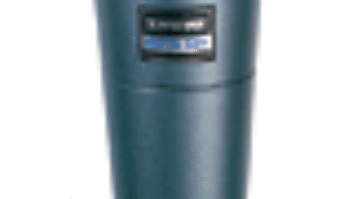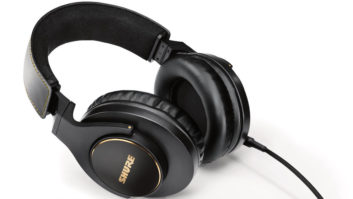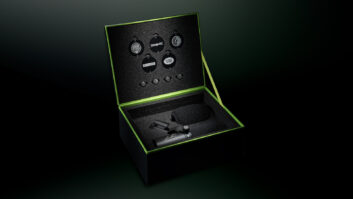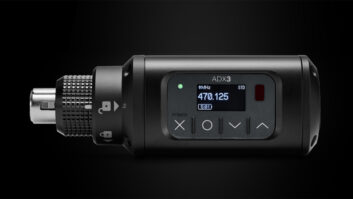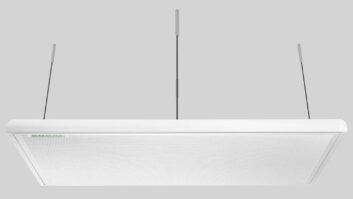The KSM44 multipattern
condenser mic is the second offering in Shure’s
KSM microphone line. It follows on the heels of the
cardioid-only KSM32, which was introduced a couple
of years ago. Shure’s intent was to optimize the KSM44’s frequency
response for vocal tracking, though the mic is well-suited for a
variety of other applications.
Considering its $1,340 list price, the solid-state KSM44 boasts a
surprisingly extensive feature set. Its three polar patterns—cardioid, omni and
bidirection al—are selected by a switch on the front of the mic
body. A 15dB pre-attenuation switch and a three-position
low-frequency response switch are found on the rear of the mic. Looking
beyond these obvious external attributes, however, it becomes clear
that rigorous attention to detail went into the design and production
of this microphone.
The side address KSM44 employs dual, 1-inch diameter, mylar
diaphragms that are only 2.5 microns thick and are layered with
24-carat gold via a vapor deposition process. The Class-A, discrete,
transformerless preamplifier helps the KSM44 achieve maximum SPLs of up
to 151 dB with the pre-attenuator switched in and the mic in Omni mode.
Self-noise is rated at a mere 7 dBA, and sensitivity is a hefty 28
mv/PA in Cardioid mode, foretelling tracks with a rock-bottom noise
floor. Omni and Bidirectional modes offer a considerably more modest
(yet respectable) 14 to 16 mv/PA output and a still hushed 10dBA
self-noise spec.
The externally biased capsule works best with phantom powering in the 44 to 52VDC range, but can
tolerate juice as low as 11VDC with only slightly decreased headroom
and sensitivity. The KSM44 is something of a current hog, typically
draining 5.4 mA at 48VDC. Unless you have a really wimpy phantom power
supply and use many modern mics simultaneously, the 44’s current drain
will not pose a problem.
The KSM44’s frequency response in Cardioid mode exhibits a smooth
boost between 2 and 8 kHz (culminating in a 3dB boost at 6 kHz) and a
still milder bump centered on 11 kHz. Response falls off fairly rapidly
above approximately 13 kHz, ending 5 dB down at 20 kHz. At a 6-inch
distance from the mic, the proximity effect causes a gradual rise below 600
Hz, reaching a maximum +5dB boost at 50 Hz.
Omni mode is virtually ruler-flat up to 9 kHz, rises +4 dB to 11
kHz, and then it drops off in similar fashion to the Cardioid mode
response. The response in Bidirectional mode is fairly typical of a
pressure-gradient, large-diaphragm condenser, with a more dramatic
boost in the lower highs compared to that produced by Cardioid mode,
twice the bass proximity effect and a gradual roll-off above 9 kHz.
Shure took several measures to reduce the KSM44’s sensitivity to
vocal plosives and to allow creative tailoring of the mic’s
low-frequency response. The aforementioned low-frequency response
switch offers three passive EQ curves: flat (no bass roll-off), a steep
18dB per octave roll-off below 80 Hz, and a milder 6dB per octave
roll-off below 115 Hz. The mic also features a fixed subsonic filter to
eliminate rumble and structureborne noise below 17 Hz. An internal
shock-mount complements the ShureLock™ elastic-suspension
shock-mount included with the mic (more on the shock-mount below). The
head grille is a three-stage affair, featuring a nylon cloth layer
inside two layers of hardened, low-carbon steel. The grille is somewhat
unusual in that the outermost grid offers far smaller apertures than
the layer beneath, a choice made for cosmetic purposes.
The zinc, die-cast mic body adds to the KSM44’s reassuring heft. The
mic weighs in at slightly over one pound and measures a little over 7
inches long and 2.2 inches in diameter at its widest point. Internal
and external connectors are gold-plated. The KSM44 ships with a
locking, foam-lined aluminum carrying case, a protective Velveteen
pouch with Velcro closure, a mic stand swivel mount and the ShureLock
elastic-suspension shock-mount—a sturdy, polycarbonate plastic
contraption that secures the base of the mic via a bombproof locking
ring, assuring absolute confidence in hanging placements.
All of my critical listening tests were performed using a Millennia
HV-3 dual-channel mic preamp. The KSM44’s spectral balance (in Cardioid
mode) falls somewhere between that of a Neumann U87 and an AKG TL-II.
The KSM44 is fuller in the low mids than a TL-II, but not quite as full
as a U87. The Shure mic offers a more detailed top end than a U87, but
it is not quite as articulate as a TL-II. The TL-II also has a bigger
low end at the extreme bottom (around 50 Hz). The KSM44 produces a
mellow, smooth midrange response, resulting in a somewhat
“neutral” sound.
The KSM44’s transient response is excellent, which is not surprising
considering its 2.5-micron membranes. But the mic also lacks depth and
air compared to the U87 and TL-II, both of which sound rounder and
offer significantly more nuance.
Next up was a test of the KSM44’s off-axis response. All three polar
patterns exhibited excellent rejection at their nulls. Cardioid mode
sounded remarkably uniform out to 30° to either side of the front
of the mic. However, I found off-axis coloration to be more pronounced
in Omni and Bidirectional modes than the supplied charts implied. In
Bidirectional mode, the sound at the rear of the mic was very muffled
and dramatically different from that produced on-axis. This could be a
problem when miking two background vocalists from different sides of
the mic, as any remedial EQ would have to be averaged for two decidedly
different sounds. Similarly, I found Omni mode produced noticeably
greater depth and detail on-axis compared to at the rear of the
mic.
On a happier note, another A/B test revealed that the KSM44 is
considerably quieter than a Neumann U87A, even after mic preamp levels
were adjusted to make up for the 44’s slightly lower (yet still very
robust) output. With mic pre channels boosted near the max, the U87A
picked up a bit of EMI buzz, while the KSM44 was as silent as a desert
night. The KSM44’s low self-noise and high sensitivity are clearly its
main strengths.
I obtained good, if not awe-inspiring, results recording both male
and female vocals with the KSM44 in Cardioid mode. The microphone’s
neutral timbre lent itself equally well to both types of vocals. The
Bidirectional mode’s enhanced proximity effect lent helpful support to
thin-sounding female vocals; the trade-offs, however, were decreased
high-end detail and increased sibilance. On softly spoken voice-overs,
the KSM44’s subterranean noise floor and high output was a lifesaver,
delivering squeaky clean tracks utterly devoid of perceivable
noise.
The three polar patterns produced dramatically different timbres
from one another. Omni mode is particularly well-suited for recording
acoustic guitar, producing a more open track with less ponderous upper
bass content than many mics would provide. And the mic’s Directional
modes dish out plenty of low-frequency support when placed close to the
source, yielding good results when tracking instruments such as
electric bass guitar.
There are bigger sounding mics on the market at competing prices;
nevertheless, the KSM44 is a high-quality microphone with its own
unique sound and winning attributes. Thoughtful design, quality
construction, an extended feature set and a generous allotment of
standard accessories provide good value for the money. The KSM44’s
excellent transient response makes it a good performer for tracking
instruments as well as vocals. And the mic’s smooth proximity effect,
neutral mids and high-frequency emphasis in Cardioid mode make it a
versatile performer for recording various vocalists. For applications
where any added noise cannot be tolerated, such as on exposed
voice-overs or spoken word recordings, the KSM44 is a strong candidate
for your consideration.
Shure, www.shure.com

